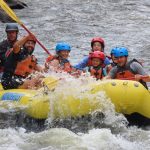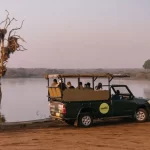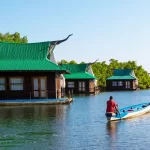Backpacking isn’t just about seeing new places; it’s about immersing yourself in experiences that transform how you see yourself and the world. Whether trekking through dense jungle trails, ancient cobbled European streets, or navigating bustling markets, traveling the globe is a uniquely diverse experience you’ll remember forever.
Unfortunately, poses many common and dangerous threats. It’s well worth your time to research your destinations, choose the right gear for the trip, budget accordingly, and prioritize your health above all else. The next time you feel your wanderlust set in, start planning your backpacking trip with our tips below to be more prepared before you set off on your backpacking adventure.
Top Backpacking Destinations & Experiences

Charming destinations await your exploration.
The world offers endless possibilities for backpackers, each destination offering its blend of obstacles and rewards. From iconic monuments to remote wilderness, the right choice depends on your interests, experience level, and what you seek from your backpacking experience. Let’s explore a few standout options catering to different backpacking styles, including Europe, Southeast Asia, and more exotic alternatives.
Backpacking Through Europe
Europe remains a classic backpacking playground, offering a dense concentration of diverse cultures, histories, and landscapes. The continent’s extensive rail network and abundance of hostels make it ideal for first-time backpackers. Start in , where you can wander through Paris’s art-filled streets or hike the rugged coasts of Ireland.
Don’t overlook the Balkans, where countries like Croatia and Montenegro offer a mix of stunning beaches and medieval towns. For a deeper dive into local rural lifestyles, consider volunteering on organic farms through programs like . Taking this approach not only cuts costs but also provides unique insights into rural European cultures.
Southeast Asian Adventures
Southeast Asia’s mix of alluring ancient culture and modern experiences offers exceptional value for budget-conscious travelers. is an ideal starting point, with Bangkok’s manic energy mellowing into serene islands and lush northern mountains. If you venture into , the ornate beauty of Luang Prabang’s Buddhist temples provides a marvelous contrast with the extreme sports and limestone karsts of Vang Vieng.
In , cycle through Hoi An’s lantern-lit cosmopolitan streets, take a junk boat tour through Halong Bay’s limestone-topped jungles, or climb into Sapa’s underrated hillscape. No matter where you wander in Southeast Asia, it’s vital to respect local cultures and customs – these vary by region and even locale, so make sure to do your research!
Alternative Experiences: Spelunking, Guided Tours, & More

Venture off the beaten path for extraordinary experiences.
If you want to push beyond conventional backpacking routes, consider blazing your own trail with unique activities like , taking a lesser-known guided tour, or dipping your toes into local cultures.
Learning can be a unique backpacking thrill, but can be dangerous if you go alone or without the proper equipment. However, there are if you look – try joining a meditation retreat, learning how to make traditional crafts, or looking into the wildlife conservation scene in your host country.
Backpacking Safety on the Go
Backpacking is the adventure of a lifetime, but it comes with many risks you should be aware of before you set off. Preparation and safety awareness are your best defenses against potential hazards. By staying alert, trusting your instincts, and taking care of both physical and mental health, you’ll be better equipped to handle whatever challenges arise on the trail.
Identifying & Avoiding Threats
Travel does come with some risks, but with situational awareness and vigilance, you can be prepared to identify potential threats and avoid them more effectively. We urge abundant caution when you’re backpacking anywhere, especially by yourself.
To backpack more safely, employ some of these invaluable strategies:

Keep an eye out for potential risks and stay alert.
- Learn the signs that a stranger has ulterior motives. Avoid anyone who relentlessly focuses on themselves, persistently steers conversations toward uncomfortable topics, or doesn’t respect your boundaries.
- Avoid displaying expensive items. Smartphones and jewelry are targets for thieves and pickpockets.
- Keep cash close and use a money belt that’s easily accessible but not visible to others.
- Trust your instincts. If a situation feels off, leave immediately and don’t look back.
- Exercise caution when accepting food and drink from strangers—some nefarious individuals drug beverages, particularly in casual settings like clubs or the street.
Mental Health & Backpacking
Spending time in nature is so beneficial for health that some people receive a prescription for it from their healthcare provider. That includes things like reducing stress and improving focus, and when you pair it with an activity like backpacking, you can increase your physical activity too.
Still, when backpacking, you may sometimes find yourself isolated or in unexpected situations. There are ways you can condition your mind to stay grounded on the go.
To maintain your mental health while backpacking, remember to:
- Stay connected. Purchase an international data plan and stay connected with loved ones while you travel to stave off loneliness.
- Meditate outdoors. Combine meditation’s potent mental health benefits and nature exposure.
- Keep a travel journal to reflect on your experiences and healthily process emotions;
- . Before leaving, try changing your routine in small but noticeable ways to get in the mindset of constant change.
Staying Healthy and Prepared

Prepare for adventure with a focus on wellness and self-care.
Backpacking demands a higher fitness standard than conventional travel, so make sure you’re staying fit. Travel can tax even the most fit travelers if unprepared, making it crucial to prioritize self-care.
To make the most of your backpacking adventure, you should:
- Stay hydrated, carry water, and identify where you can obtain clean drinking water at each stop.
- Maintain proper nutrition. We know it’s hard with so many delicious food options around the world, but it is essential.
- Get enough sleep. You need 7 to 9 hours of rest each night to keep your body in robust physical condition.
- Learn food and water safety, such as how to clean your water, spot rotten food, and avoid unsafe foods and water.
Preparing for Your Backpacking Adventure
Backpacking trips require more than just a sense of adventure – proper preparation can make the difference between a memorable journey and a series of misadventures. Before hitting the trail, let’s break down the key elements you’ll need to consider: planning your itinerary, proper budgeting, and what to bring with you.
Planning Your Route

Map your journey and be ready for exciting detours.
Poor planning is a common pitfall of the novice backpacker, but taking the time to plot your itinerary will melt away the worst of the stress. Having all this information in one place, like a travel folder, helps give you a concrete sense of progress once you embark.
To start planning your backpacking route today, make sure to:
- Realistically evaluate your fitness and traveling experience when determining the length of your trip.
- Try going on short camping trips near home to test your stamina.
- Consider whether you want to .
- Leave room in your schedule for unexpected discoveries or rest days.
- Research thoroughly. Learn about the weather, landscape, cities, wildlife, and hazards along your route.
Budgeting for Backpackers
Backpacking is a great way to spend a gap year, but to balance obligations at home with your adventure budget.
To budget for your backpacking trip, you should:
- Estimate daily costs for housing, food, and transportation in your target destinations.
- Factor in one-time expenses like visas and travel insurance.
- Create a healthy buffer for emergencies, fancy meals, souvenirs, and the occasional splurges.
- Consider ways to stretch your budget, such as work-exchange programs or choosing destinations where your currency goes further.
Essential Gear & Other Products to Pack

Gear up with essentials for a smooth and sustainable adventure.
The items you carry can make or break your backpacking trip, particularly if you’re traveling to remote locations where you can’t quickly restock or grab gear at the last minute. Travelers can contribute to a lot of waste in host countries, so we recommend when possible.

























